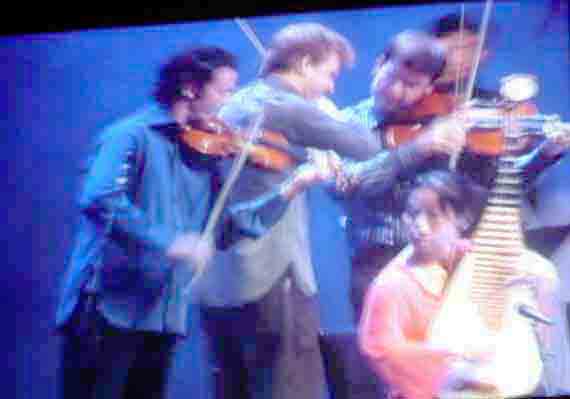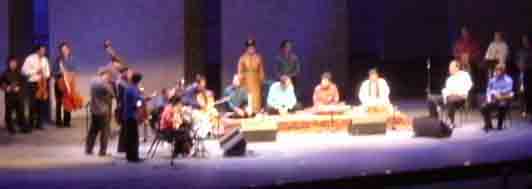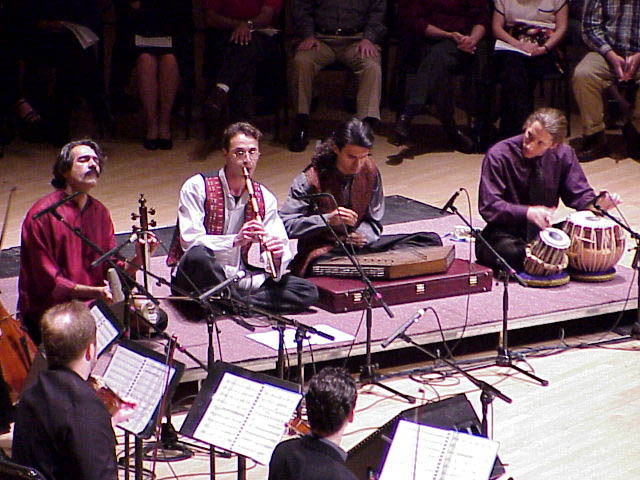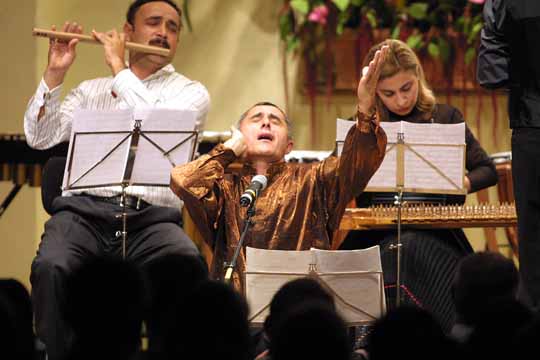For those who state the well-founded position that there is a great poverty
of imagination from much of the music world, hearing Yo-Yo Ma’s
Silk Road Project provides a tangible hope that there might be a great
future ahead of us. Utilizing music as a tangible expression to communicate
one’s most profound aspirations while transcending self-imposed
humanistic restrictive borders/conflicts among us – Silk Road Project
was and is a celebration of what the arts should aspire to be.
| |
 |
|
 |
The
sold-out multicultural audience of 18,000+ people at the Hollywood Bowl
of all ages sent a strong signal that, despite the various issues of diversity
in the media and the clashes between various racial groups, many ethnically
diverse communities can come together to celebrate as one voice. The broad
spectrum of the appreciative audience came close to matching the diverse
collection of musical visionaries within Silk Road Project such as Yo-Yo
Ma, Siamak Aghaei, Mike Block, Nicholas Cords, Sandeep Das, Joel Fan,
Ganbaatar Khongorzul, Jonathan Gandelsman, Joseph Gramley, Colin Jacobsen,
Siamak Jahangiry, Kayhan Kalhor, Liu Lin, Max Mandel, Shane Shanahan,
Mark Suter, Wu Man, Wu Tong, DaXun Zhang, Miles Anderson, Michael Becker
and James Miller.
Yo-Yo
Ma was the genial emcee, enthusiastic ringleader, embracing creative center,
driving force and the music’s “common ground” for Silk
Road Project’s polystylistic creativity where he was almost having
more fun than the audience – as noted by the various images that
were displayed at the Hollywood Bowl’s various large television
screens. Most of the time, he was just another component of an exciting
musical ensemble while incorporating his playing of various instruments
such as the ancient two-string morin khun – along with his famed
cello.
 |
|
This unique
creative vision – Silk Road Project – has become a smoothly
integrated musical collective whose latest performance has seamlessly
combined old things (musically) together to form new visions and/or
approached old things (traditional music from the various regions
along the fabled Silk Road)) in new ways. It ranged from Byambasuren
Sharav's "Legend of Herlen," with three local trombonists
punctuating the meditative Mongolian textured composition the flair
of a Western horn section to Ganbaatar Khongorzul mesmerizing the
massive crowd with her wailing, extended outbursts of "long
song." |
|
 |
This
diversity was also seen in Yo-Yo Ma playing within the piquant scales
of the Persian music to the multi-layered timbres of the Chinese
compositions to the pulsating rhythms of Roma Gypsy works. |
"Ambush
From 10 Sides” provided the fusion based on a tone poem about an
ancient Chinese battle that included various percussive punctuations that
highlighted the impressive work of pipa virtuoso Wu Man and Wu Tong’s
harmonica-like passages from a sheng utilized in a fashion of an acoustic
rock guitar-type strumming. The gypsy-flavored selections allowed Wu Man
to play the pipa in a sedate fashion within the delicate Persian classical
musical textures.
The
drone-based workout "Blue as the Turquoise Night of Neyshabur"
continued the meditative nature of the various Persian-based compositions.
The night featured various performance combinations from 2 to 3 performers
(within the Persian composition that was a little too long) to a full
ensemble.
The
night ended on a high note with the full ensemble performing various selections.
With the crowd asking for more, the encores included compositions where
the various musicians were "playing off of each other" (improvising)
that included extended solos on their respective instruments in full-fledged
celebration of the magic and unity that existed that night. The audience
was a recipient and beneficiary of the collective joy of the musicians
reveling in a night where all our respective differences became a collective
strength and a reason to celebrate.
| |
|
|
| Help Us Make US Asians Meet Your Needs |
Participate in our survey by clicking HERE
| |
|
Any questions regarding the content, contact Asian American Artistry
site design by Asian American Artistry
Copyright © 1996-2006 - Asian American Artistry - All Rights Reserved.

